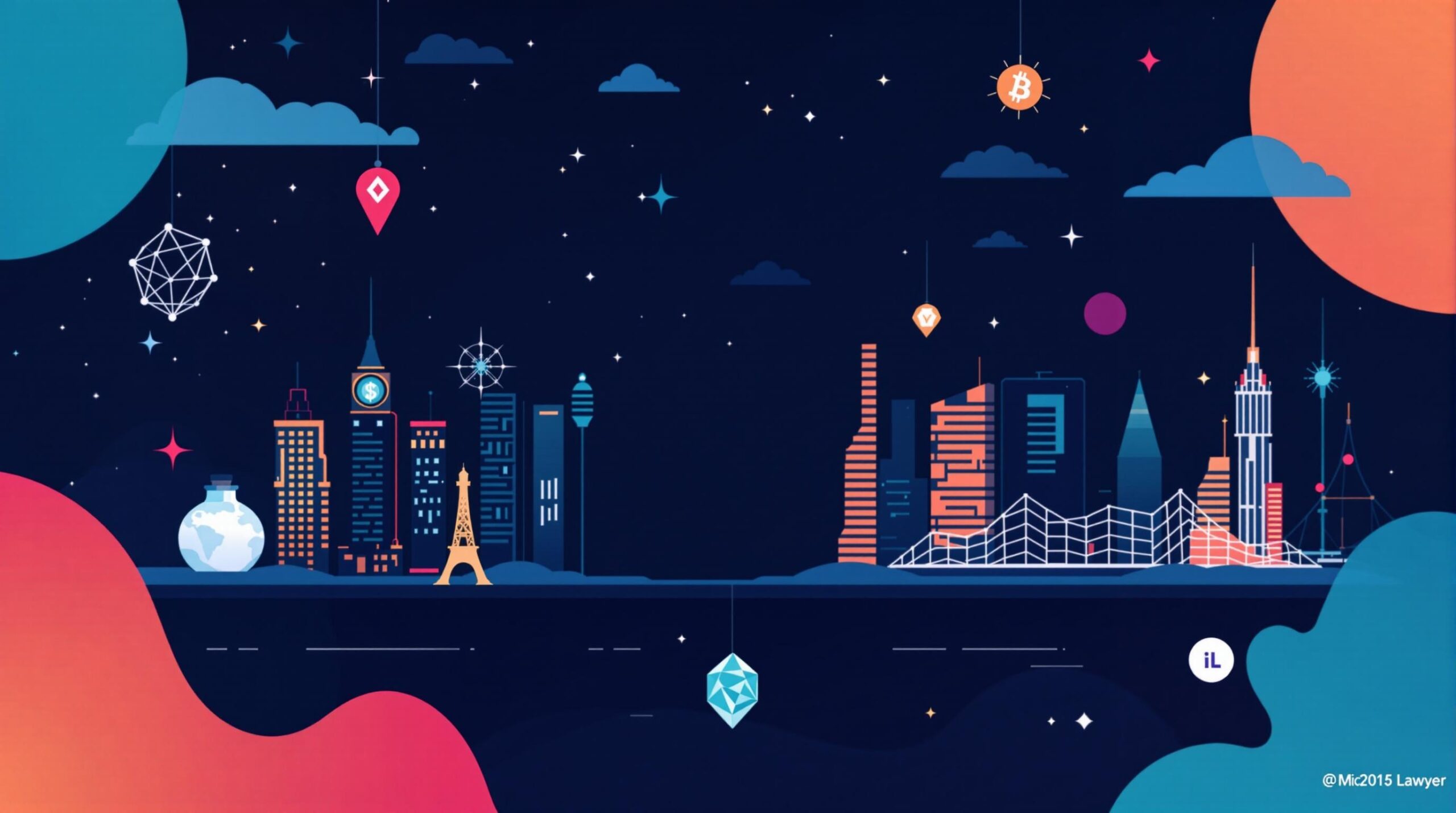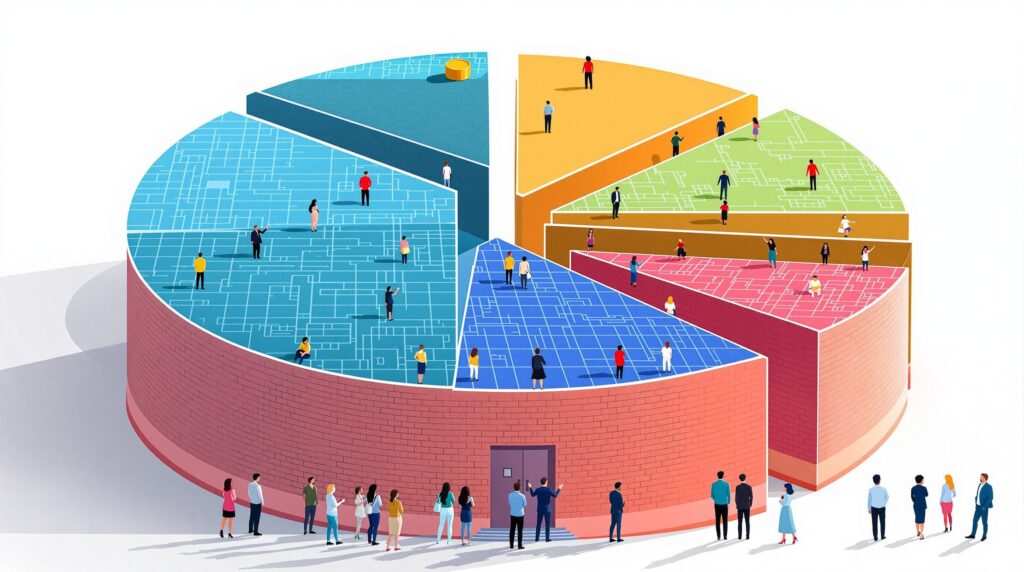[rev_slider alias=”slider-1″][/rev_slider]
Introduction to Decentralization
Have you ever wondered what makes blockchain technology so revolutionary? At the core of its transformative power lies the principle of decentralization. In simplest terms, decentralization refers to the distribution of control and decision-making from a central authority to multiple nodes or actors across a network. This foundation is what differentiates decentralized systems from traditional, centralized models.
What is decentralization in blockchain technology? Decentralization is the dispersion of control and governance across a network, which enhances security, transparency, and resilience against tampering or outages.
Decentralization is crucial because it forms the backbone of blockchain solutions like Layer 1 and Layer 2 networks. But what exactly are these layers, and how do they differ? Understanding these layers can give us insight into how they uniquely contribute to the effectiveness and scalability of blockchain systems.
The Significance of Layer 1 Blockchains
Layer 1 blockchains represent the base network of a blockchain system. Think of them as the foundational layer that handles essential tasks like security, consensus, and programming language rules. These blockchains are self-sufficient and operate independently. Bitcoin and Ethereum are leading examples of Layer 1 blockchains. They are responsible for the fundamental protocol and ensure the integrity of the entire system.
- Security: Layer 1 blockchains are known for their robust security features due to consensus mechanisms like Proof of Work or Proof of Stake. Explore more about security measures in legal terms for deeper insights.
- Independence: They do not rely on other networks for their core operations, making them distinct in their functionality.
- Consensus: This process ensures all transactions are verified and added to the blockchain in a secure manner.
As Africa becomes increasingly involved in the digital space, Layer 1 blockchains play a vital role in establishing a secure and reliable infrastructure. For instance, the $JARA token is building Africa’s digital asset economy using proprietary Layer 2 blockchain technology, while leveraging the foundational benefits of Layer 1 networks.
Layer 2 Solutions: Scaling Beyond the Basics
While Layer 1 blockchains are strong pillars of decentralization, their capabilities to handle a growing number of users and transactions can be limited. This is where Layer 2 solutions come into play, providing what can be seen as an expansion pack to the base layer.
- Scalability: Layer 2 solutions enhance transaction speeds and reduce fees without compromising the security of the Layer 1 blockchain.
- Flexibility: They offer tailored solutions to particular blockchain applications, catering to specific user needs and conditions.
- Innovation: Many new apps and functionalities, such as enhanced privacy protocols, are often first developed on Layer 2.
How do Layer 2 solutions work? Layer 2 solutions operate by processing transactions off the primary blockchain and then relaying the final results back, increasing speed and reducing costs efficiently.
Jara’s proprietary Layer 2 blockchain is a prime example of leveraging these solutions to fuel the steadily advancing African digital market. Their innovative use embodies a social-first approach designed for the WhatsApp generation.
In a rapidly digitizing world, understanding the dynamics of decentralization through Layer 1 and Layer 2 frameworks is invaluable. By bridging advanced technology with practical applications, especially in emerging markets like Africa, we inch closer to a future that is more connected yet independent—one where individuals have greater access to economic opportunities and the control that decentralization promises.
Understanding Layer 1 Blockchains
Key Players and Innovations
The digital age has introduced us to groundbreaking technologies, and blockchain is undoubtedly at the forefront. But what exactly is a Layer 1 blockchain, and who are the main players driving this innovative space? Let’s dive into the dynamic world of Layer 1 blockchains, praising their pivotal role as the backbone of the decentralized ecosystem and exploring the innovations that set them apart.
Layer 1 blockchains are foundational networks in the blockchain hierarchy that process fundamental transactions and serve as the main database ledger, supporting a plethora of decentralized applications (dApps) and protocols.
Layer 1 blockchains provide the essential infrastructure for the decentralized web, enabling direct transactions across various sectors without the need for intermediaries. The question arises: Who are the major players in this arena? Let’s explore some leading Layer 1 blockchain platforms that are shaping the future of decentralization.
- Ethereum: Often referred to as the ‘king’ of smart contracts, Ethereum brought programmability to blockchain and plays host to a multitude of decentralized applications. Despite facing challenges like high transaction fees, Ethereum’s innovative upgrades like Ethereum 2.0 aim to boost scalability and performance.
- Bitcoin: As the original cryptocurrency, Bitcoin might not offer smart contracts like its counterparts, but it has the distinction of being the most secure and widely adopted cryptocurrency, reinforcing its position as a digital store of value.
- Binance Smart Chain (BSC): Known for its lower fees and faster transaction speeds, BSC competes by integrating smart contract functionality with increased efficiency, gaining traction among developers and users alike.
- Cardano: Cardano’s distinctive academic approach to blockchain development has enforced its reputation as one of the most secure and sustainable platforms, making it appealing for developing countries seeking robust technological frameworks.
- Solana: Solana stands out with its incredibly high throughput capabilities, offering fast, secure, and scalable dApps and crypto projects. This positions it as a strong competitor in the race for blockchain supremacy.
Interestingly, the diversity and specialization of these platforms depict the wider trend towards decentralization and financial inclusion. In particular, Africa’s budding digital asset economy finds these innovations highly relevant as citizens across the continent embrace crypto solutions to transcend traditional financial systems.
Africa is making remarkable strides towards embracing blockchain technology, recognizing the potential of Layer 1 blockchains in contract automation, cross-border transactions, and to support sustainable development. This shift promises new opportunities for economic empowerment across the region.
It’s essential to understand how these platforms interact within the larger context of decentralization. Each one brings a unique offering to the table, leading to fierce competition and continuous innovation. For instance, platforms like Ethereum and Cardano are exploring more energy-efficient consensus mechanisms, while others like BSC and Solana are enhancing speed and cost-effectiveness.
The implications of these advancements extend beyond just transaction speed and efficiency. They foster an environment for the growth of decentralized finance (DeFi) applications and digital asset management, bridging financial gaps and offering new economic models.
In conclusion, the significant influence of Layer 1 blockchains on Africa’s digital landscape cannot be overstated. The rise of innovative blockchains like those spearheaded by Jara showcases a strategic alignment with the continent’s needs, which strategically benefit from the evolving digital economy. As we continue to witness the dynamic shifts in this space, it’s clear that Layer 1 blockchains remain a critical component in setting the stage for a decentralized future.
[rev_slider alias=”text-call-cta”][/rev_slider]
The Role of Layer 2 Solutions
In the dynamic world of blockchain, addressing scalability issues on Layer 1 blockchains remains a hot topic. But what if there was a way to enhance scalability without altering the foundational layer? Enter Layer 2 solutions, which act like express lanes on a highway. But what role do these solutions play, and why are they crucial to the future of blockchain?
What are Layer 2 solutions? Layer 2 solutions are supplementary frameworks built on top of Layer 1 blockchains to improve transaction speed, reduce costs, and increase scalability.
Imagine a bustling city where traffic congestion is a daily struggle. To alleviate this, urban planners build overpasses and underpasses instead of widening the existing roads. Similarly, Layer 2 solutions are designed to enhance the performance of Layer 1 blockchains without tampering with their underlying protocols.
Why We Need Layer 2 Solutions
Layer 1 blockchains, like Ethereum and Bitcoin, are hailed for their security and transparency. However, they suffer from a significant drawback: limited scalability. As more users adopt these blockchains, the transaction time increases, and fees rise—often making the networks less efficient and more costly.
- Key Concept: Limited Scalability – Most Layer 1 blockchains struggle with a high volume of transactions, leading to congestion and increased costs.
Layer 2 solutions come into play by handling the bulk of transactions off-chain and then settling them on the primary chain. This not only relieves the congestion on Layer 1 but also significantly reduces transaction costs.
Examples of Successful Layer 2 Implementations
To better understand the impact of Layer 2 solutions, let’s examine some successful implementations:
- Lightning Network: Specifically designed for Bitcoin, the Lightning Network allows for micropayments to be processed off-chain, dramatically increasing the number of transactions per second while reducing fees.
- Polygon (formerly Matic): Known for its low transaction fees, Polygon is a popular Layer 2 solution built for Ethereum. It helps developers create user-friendly and efficiently scaled dApps (decentralized applications).
What makes these solutions stand out? They focus on improving user experience by ensuring fast and affordable transactions, which encourages broader adoption and trust in blockchain technology.
The Impact on Africa’s Blockchain Landscape
Africa, known for its rapid digital transformation, stands to benefit greatly from Layer 2 solutions. Currently, the region faces challenges like limited financial infrastructure and high transaction costs, which can be detrimental to businesses and individual users alike. Layer 2 solutions offer a potential remedy by providing more efficient and accessible financial networks.
Africa’s blockchain journey: Leveraging Layer 2 solutions can bridge the gap in digital infrastructure, promoting financial inclusion across the continent.
Initiatives such as the $JARA token are set to harness the power of Layer 2 solutions to fuel Africa’s burgeoning digital asset economy. With projects like Jara’s adoption, Africans can enjoy more efficient and cost-effective financial services, thereby facilitating a seamless digital transition.
As we navigate these developments, it’s essential to remain informed and prepared for the changes on the horizon. Whether you’re a blockchain aficionado or a newcomer, it’s clear that Layer 2 solutions will play a pivotal role in shaping the decentralized future.
Future Trends in Blockchain Technology
Emerging Technologies and Challenges
The blockchain landscape is constantly evolving, and as we look to the future, understanding the emerging technologies and challenges in this space becomes crucial. In particular, the distinctions and advancements between Layer 1 and Layer 2 technologies will play a pivotal role in steering the future of decentralization. Let’s delve into these upcoming trends and the potential obstacles that the industry faces in its journey towards widespread decentralization.
What is Layer 1 Blockchain? Layer 1 blockchains are the foundational networks in blockchain architecture, on which Layer 2 solutions are built to enhance scalability and efficiency.
Layer 1 networks, such as Bitcoin and Ethereum, have formed the bedrock of the blockchain ecosystem. However, as demand for blockchain-based solutions increases, the limitations of these networks in handling high transaction volumes have become evident. This is where Layer 2 technologies come into play. Layer 2 solutions, like Lightning Network and Ethereum’s Rollups, are designed to increase the scalability of Layer 1 blockchains by introducing off-chain processing.
- Advancement in Layer 2: Technologies like rollups enable faster transaction processing without compromising security.
- Scalability Solutions: Layer 2 solutions aim to handle thousands of transactions per second, compared to the limited scalability of Layer 1 blockchains.
However, the path to widespread adoption isn’t without its hurdles. One significant obstacle is the issue of interoperability. With numerous blockchains operating independently, achieving seamless interoperability remains a critical challenge that the industry must overcome to realize truly decentralized solutions.
What is Interoperability in Blockchain? It refers to the ability for different blockchain networks to communicate and transact with each other seamlessly.
Additionally, security remains a paramount concern. As blockchain technology matures, so do the strategies of cybercriminals looking to exploit vulnerabilities within these networks. This means continuous adaptation and enhanced security protocols are necessary to safeguard digital assets and maintain trust in the system.
- Enhanced Security Measures: Implementing advanced cryptographic techniques to protect user data and transactions.
- Innovative Protocols: Development of new consensus mechanisms to enhance both security and efficiency.
As Africa becomes a significant player in the digital asset market, the role of platforms like Jara becomes increasingly vital. With their proprietary Layer 2 solutions and focus on tokenizing real-world assets, Jara stands at the forefront of this revolution, bridging global capital to African markets. By facilitating interoperability and driving security enhancements, platforms like Jara are poised to lead the charge towards a future where blockchain technology empowers every individual on the continent.
“Bridging Global Capital to African Assets” – Jara is committed to revolutionizing the digital economy by unlocking the immense potential of African markets.
[rev_slider alias=”schedule-consultation-btn”][/rev_slider]

What is the difference between Layer 1 and Layer 2 blockchains?
Layer 1 blockchains refer to the base layer or the main blockchain architecture, which manages the primary operations like transactions and consensus directly on the network. In contrast, Layer 2 blockchains are secondary frameworks built on top of Layer 1, designed to improve scalability and speed by processing transactions off-chain or in batches.
How do Layer 2 solutions enhance blockchain scalability?
Layer 2 solutions enhance blockchain scalability by processing transactions outside of the main chain (Layer 1) and reducing the amount of data the main chain has to process. This is achieved through scaling techniques like state channels, sidechains, and rollups, which handle large transaction volumes at high speeds and lower costs.
What are the security considerations for Layer 1 and Layer 2 blockchains?
Security considerations for Layer 1 blockchains include maintaining decentralized consensus and protecting against attacks such as 51% attacks. Layer 2 blockchains must ensure secure linkage back to the Layer 1 chain to prevent unauthorized transactions and ensure data integrity. Protocol upgrades and auditing are critical for both layers to enhance security.
Which emerging Layer 1 blockchain technologies are noteworthy?
Emerging Layer 1 blockchain technologies include platforms like Ethereum 2.0, which is transitioning to a proof-of-stake model, and Polkadot, which focuses on interoperability among different blockchains. These platforms are noteworthy for their innovative approaches to solving scalability, speed, and energy efficiency challenges in the blockchain space.

Related Practice Areas
Explore other practice areas we specialize in to better understand our expertise in the blockchain sector.
Hear From Our Satisfied Clients
Serving our Layer 1 and Layer 2 blockchain solutions clients with complete dedication, every case is a testament to our hard work. The appreciative feedback we receive underscores our commitment to excellence.

[rev_slider alias=”slider-3″][/rev_slider]
[rev_slider alias=”slider-6″][/rev_slider]
Connect with the Future of Blockchain Technology
Join the revolution in decentralization. Whether you’re exploring Layer 1 innovations or leveraging Layer 2 solutions, we are your trusted partner in navigating the ever-evolving world of blockchain technology.
At Jara, we bridge global capital to African assets, empowering you to lead with cutting-edge blockchain solutions. Ready to take the next step? Contact us today through our website or download the Jara app on Android and iPhone for easy access to our services.
“Don’t just take our word for it.”
We’re proud to be recognized among the top leaders in the blockchain industry:
- Highlighted in the “Top Blockchain Innovators of 2023”, by Blockchain Review. Criteria: Innovative contributions to blockchain technology. View Award
- Featured among the “Best Layer 1 Blockchain Firms”, by Global Crypto Awards. Criteria: Excellence in Layer 1 and Layer 2 solutions. View Award
- Listed in the “Fintech Pioneers of the Year”, by Fintech Magazine. Criteria: Pioneering advancements and fintech solutions. View Award
- Acknowledged in “Top Decentralization Leaders”, by Tech Innovators. Criteria: Leading efforts in decentralization. View Award
- Named as a “Visionary Blockchain Developer”, by Innovative Blockchain Awards. Criteria: Visionary approaches to blockchain challenges. View Award
Be part of a network that’s shaping the future. Discover how we can help you lead in the decentralized ecosystem.
Chinyere “Chi” Nnadi Bio
Founder and CEO, Jara | Blockchain and Decentralization Specialist
Content Reviewed by Chi Nnadi and his Content Team. Chi is a seasoned entrepreneur dedicated to transforming Africa’s financial landscape through blockchain technology. As Founder and CEO of Jara, he constructs enterprise-grade infrastructure converting illiquid African assets into globally accessible digital tokens. With his proprietary Layer-2 blockchain technology, Chi connects global investors with Africa’s burgeoning digital asset marketplace.
Our Content Review Process
Chi Nnadi along with Jara’s dedicated content team, pledge to offer top-notch material. Our content guidelines ensure thoroughness, reputable sources, unbiased scrutiny, among other quality metrics. Please let us know if there is anything you believe to be inaccurate.
















